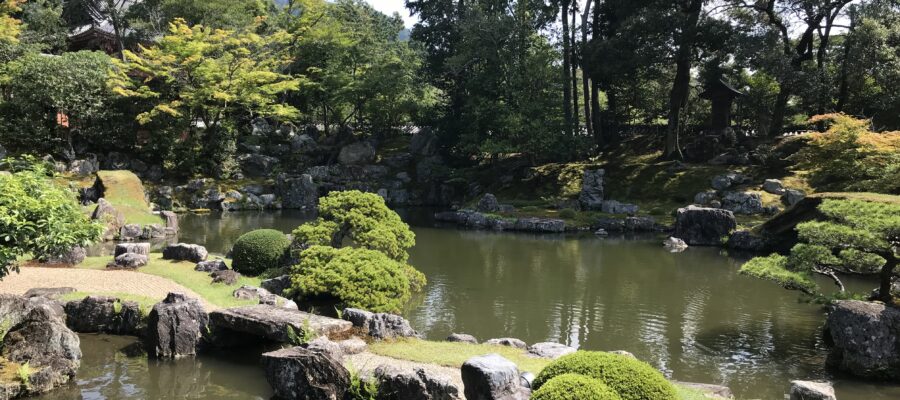秀吉が設計した庭
霊宝館の後、三宝院に入りました。現在の三宝院は秀吉が1598年に催した「醍醐の花見」を契機に整備され、庭園は秀吉自ら基本設計をしたもので、国の特別史跡・特別名勝に指定されています。
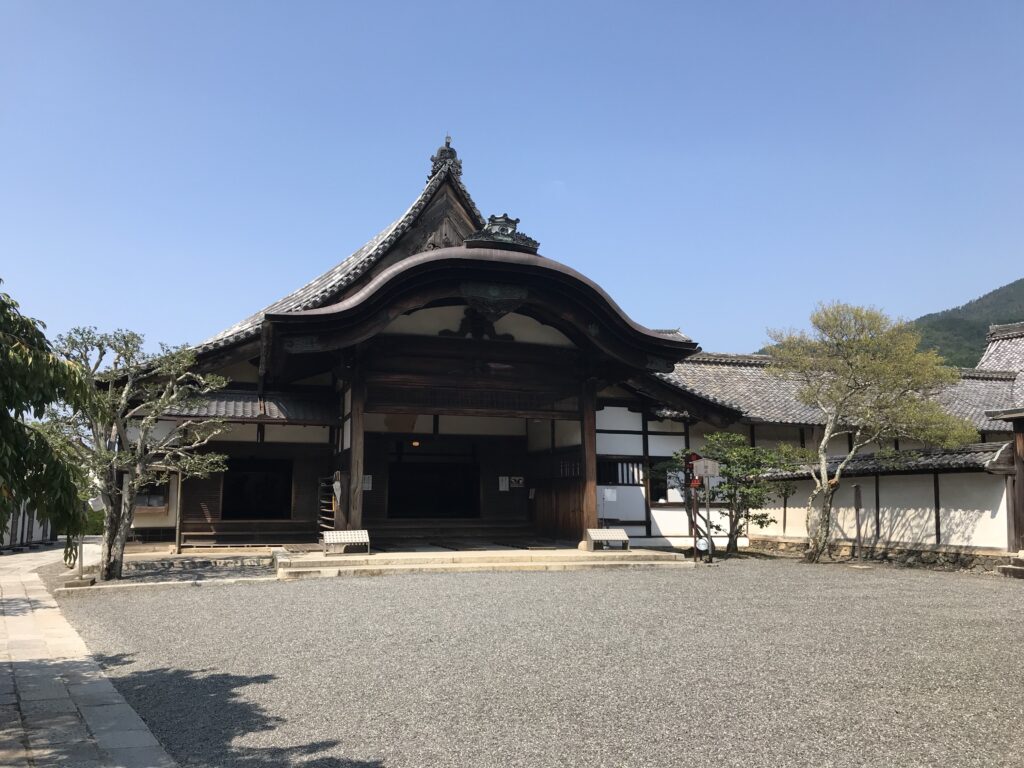
豪華な襖絵のある部屋を見ながらどんどん奥に進んでいくと、庭全体が見渡せる国宝の表書院に到着します。ずいぶん奥行きのある広々とした庭です。石の配置も自然なように感じられます。真夏日の暑さの中、ほっと一息つきながら、表書院の奥まで歩いていきました。
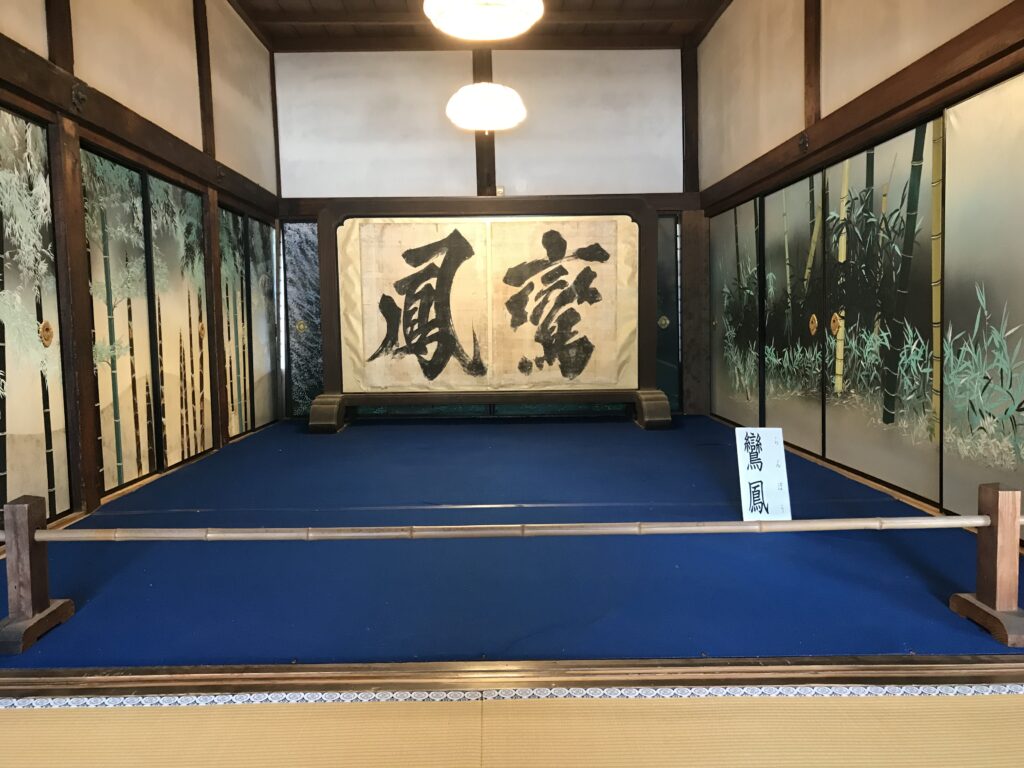
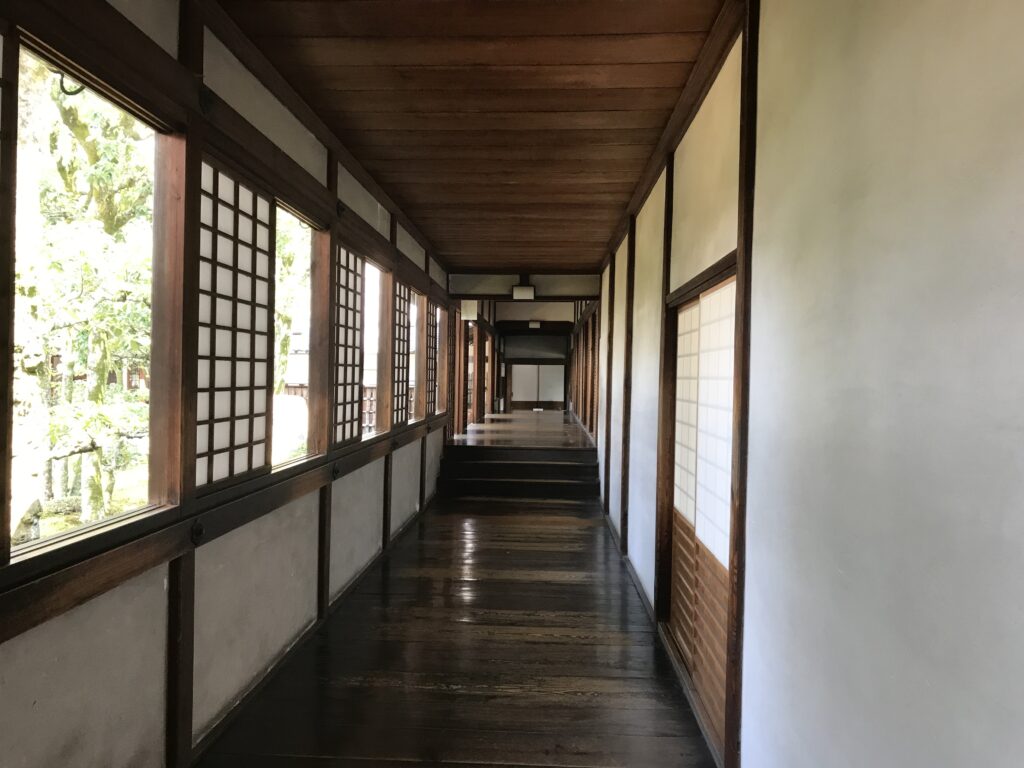
このお寺も明治の廃仏毀釈の折に、寺領を国に返還したため、財政基盤が大きくゆれて衰退の一途をたどり始めたようですが、一切の宝物を外部流出させることなく難を乗り切ったそうです。先人の努力のおかげで、たくさんの国宝、重要文化財が保存されています。
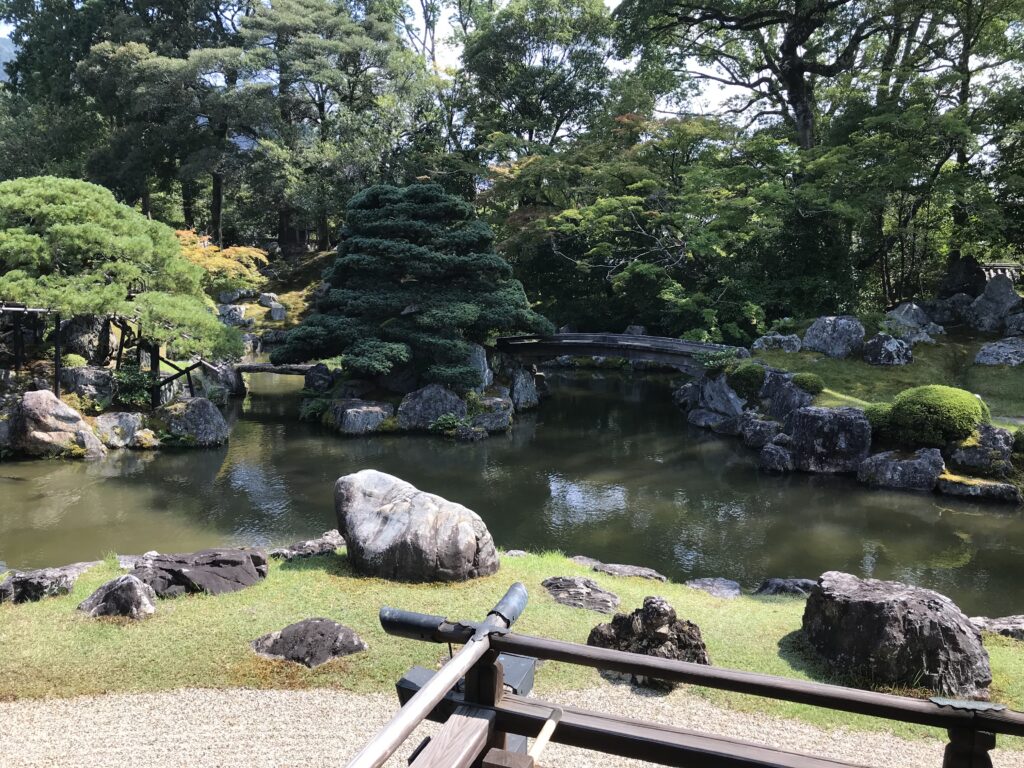
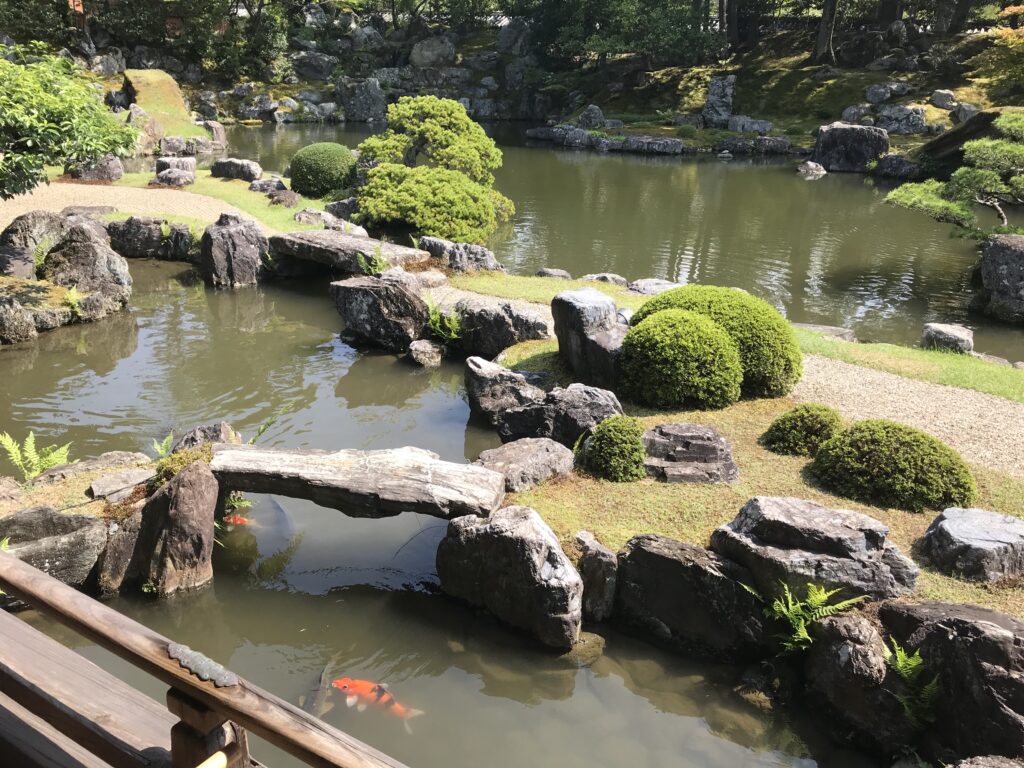
藤戸石
庭を眺めていますと、池の向こうに1つ目につく石が立っています。藤戸石と呼ばれる石で、この石は歴代の為政者の手を渡ってきた歴史があります。織田信長が室町幕府15代将軍の足利義昭のために(旧)二条城を建てた際に、この藤戸石が丁寧に包装され、京の人々が見守る中、細川邸から二条城に運ばれたそうです。
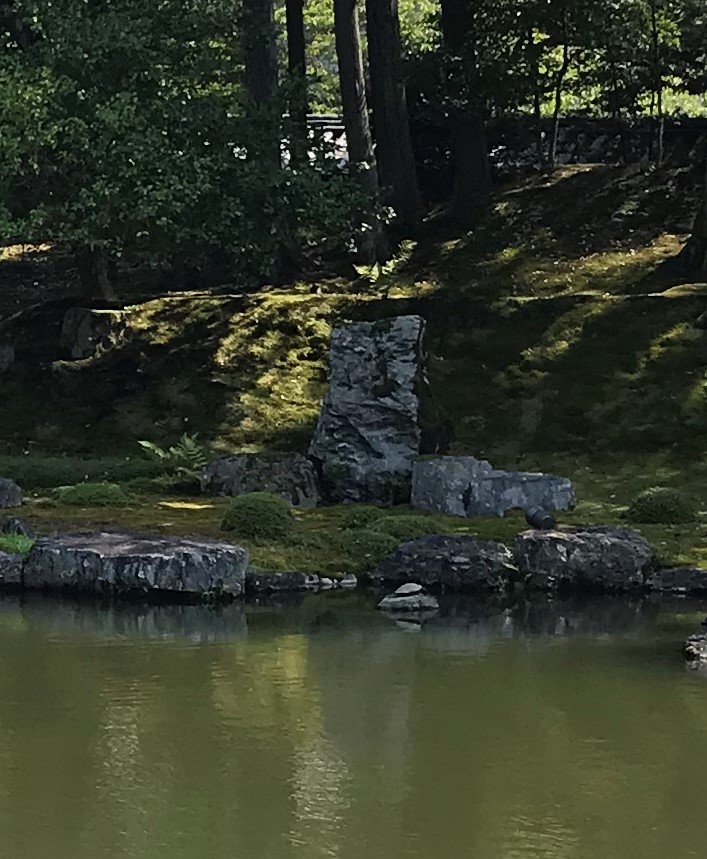
その後、天下人となった秀吉の手を経て、この三宝院に運ばれ、今日に至るそうです。たかが石ひとつなのですが、このようなストーリーを聞くと、その辿ってきた歴史が投影されて貴重なものに見えてきます。(完)
三宝院を紹介した書籍
烏賀陽百合さんの「しかけに感動する『京都名庭園』」に醍醐寺の三宝院が紹介されています。
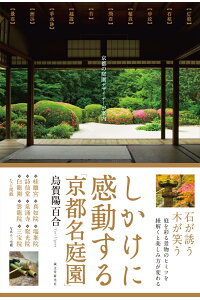
しかけに感動する「京都名庭園」 京都の庭園デザイナーが案内 [ 烏賀陽 百合 ]
価格:1,760円
(2021/5/2 18:44時点)
感想(1件)
Daigoji Temple Sanpoin Garden (English)
A garden designed by Hideyoshi
After the Reihokan, I entered the Sanpoin Garden. The current Sanpo-in was built after Hideyoshi’s “Cherry blossom viewing in Daigo” event in 1598, and the garden was designed by Hideyoshi himself and is designated as a special historic site and a special place of scenic beauty.
As I walked further and further into the temple building, looking at the gorgeous Fusuma (sliding paper door) paintings, I arrived at the Omote-Shoin building, a national treasure overlooking the entire garden. The garden is quite deep and spacious. The arrangement of the stones seems to be very natural. In the mid-summer heat, I took a breather and walked to the back of the Omote-Shoin building.
During the Meiji period (1868-1912), the temple’s territory was returned to the government, and the temple’s financial base was shaken and it began to decline. Thanks to the efforts of our predecessors, many national treasures and important cultural assets have been preserved.
Fujito Rock
As I looked around the garden, I noticed a stone standing across the pond. This stone is called Fujito Rock, and it has a history of passing through the hands of successive generations of politicians.When Oda Nobunaga built the (former) Nijo Castle for Ashikaga Yoshiaki, the 15th shogun of the Muromachi Shogunate, this Fujito stone was carefully wrapped and brought from Hosokawa’s residence to Nijo Castle while the people of Kyoto watched.
After that, it passed through the hands of Hideyoshi, who became the most powerful Feudal Lord of Japan, and was brought to Sanpoin Garden, where it remains today. It is only a single rock, but when you hear the story, the history of the rock is projected onto it, making it seem more precious. (End)
Temple Daigoji – Jardin Sanpoin (Français)
Un jardin conçu par Hideyoshi
Après le Reihokan, je suis entré dans le jardin Sanpoin. L’actuel Sanpo-in a été construit après l’événement de Hideyoshi “Observation des cerisiers en fleurs à Daigo” en 1598, et le jardin a été conçu par Hideyoshi lui-même et est désigné comme un site historique spécial et un lieu spécial de beauté scénique.
En m’enfonçant de plus en plus dans le bâtiment du temple, en regardant les magnifiques peintures Fusuma (porte coulissante en papier), je suis arrivé au bâtiment Omote-Shoin, un trésor national qui surplombe tout le jardin. Le jardin est assez profond et spacieux. La disposition des pierres semble être très naturelle. Dans la chaleur du milieu de l’été, j’ai fait une pause et je me suis rendu à l’arrière du bâtiment Omote-Shoin.
Pendant la période Meiji (1868-1912), le territoire du temple a été rendu au gouvernement, et la base financière du temple a été ébranlée et il a commencé à décliner. Grâce aux efforts de nos prédécesseurs, de nombreux trésors nationaux et biens culturels importants ont été préservés.
Fujito Rock
En regardant le jardin, j’ai remarqué une pierre qui se trouve de l’autre côté de l’étang. Lorsque Oda Nobunaga a construit l’ancien château de Nijo pour Ashikaga Yoshiaki, le 15e shogun du shogunat Muromachi, cette pierre Fujito a été soigneusement emballée et transportée de la résidence de Hosokawa au château de Nijo sous les yeux des habitants de Kyoto.
Il est ensuite passé entre les mains de Hideyoshi, qui est devenu le plus puissant seigneur féodal du Japon, et a été transporté au jardin Sanpoin, où il se trouve encore aujourd’hui. Ce n’est qu’un simple rocher, mais lorsque vous écoutez l’histoire, l’histoire du rocher est projetée sur lui, ce qui le rend plus précieux. (Fin)
